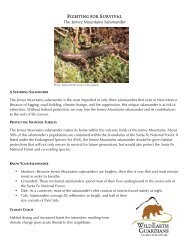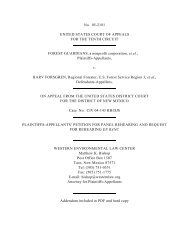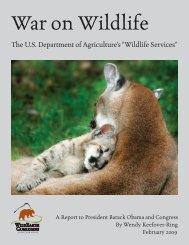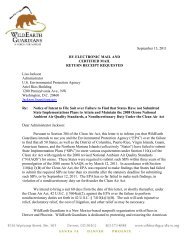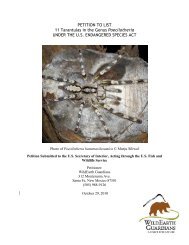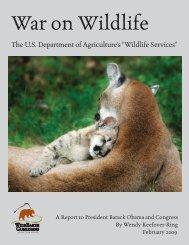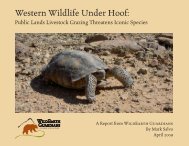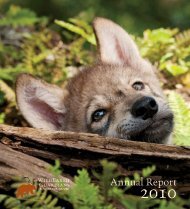PETITION TO LIST THE JEMEZ MOUNTAINS SALAMANDER ...
PETITION TO LIST THE JEMEZ MOUNTAINS SALAMANDER ...
PETITION TO LIST THE JEMEZ MOUNTAINS SALAMANDER ...
Create successful ePaper yourself
Turn your PDF publications into a flip-book with our unique Google optimized e-Paper software.
WildEarth Guardians Petition to List<br />
Jemez Mountains Salamander Under the ESA<br />
37<br />
and research on this disease. It is not know what effects the fungus will have on the<br />
Jemez Mountains salamander, but given the capacity of this disease to cause large<br />
mortality events, the threat to populations of Jemez Mountains salamanders is great.<br />
IV.<br />
Inadequacy of Existing Regulatory Mechanisms<br />
The Jemez Mountains salamander is imperiled throughout its range. Although federal<br />
and state agencies have signed agreements to afford protection to this species, the<br />
conservation measures in those agreements have failed to result in stabilizing or<br />
increasing populations and it is believed that Jemez Mountains salamander populations<br />
have decreased (Cummer et al. 2005). The lack of federal protection for this species has<br />
resulted in more isolated and fragmented populations. Crucial habitat has been<br />
threatened multiple times and in certain instances was destroyed or degraded due to<br />
human actions.<br />
Although regulatory documents include the MOA (USFS 1991), the Forest Plan<br />
and its amendments regarding federally threatened and endangered species and<br />
USFS sensitive species (USFS 1987; USFS 2004), the CMP (NMEST 2000b),<br />
and the Conservation Agreement between and among the USFS, USFWS and<br />
NMDGF (USFS 2000), the USFS continues to pursue activities which have<br />
destructive consequences for populations of the Jemez Mountains salamander and<br />
the habitat it requires (Tables 4 and 5). The central problem is that the MOA, or<br />
the CMP, have no legal authority for enforcement. For example, the NMEST can<br />
make suggestions to USFS, but there is no legal standing in the MOA that they<br />
have to follow the NMEST’s recommendations.<br />
While the CMP clearly states that Category 1 activities threaten the persistence of the<br />
Jemez Mountains salamander and that Category 2 activities, while at times necessary, are<br />
also detrimental to individuals and their habitat, these activities have continued to be<br />
conducted and/or proposed within the Essential Zone and Priority Survey Zone, under<br />
supervision of the US Forest Service. Cumulatively they have resulted in the decline of<br />
Jemez Mountains salamander subpopulations and added to large-scale destruction of<br />
suitable habitat.<br />
Species status history state, federal, national and global status ranks and listings<br />
As discussed previously, in 1992 the species the species was found not to warrant ESA<br />
listing based on the signing of the 1991 MOA (57 FR 11459). At that time the species<br />
was listed as threatened by the state of New Mexico. The species was reclassified in<br />
1996 to a Federal Species of Concern, which provides no protection or triggers for<br />
federal listing. In 1997, the Global Heritage Program ranked the salamander with a G2<br />
status (rare/imperiled). During this same year the New Mexico Heritage Program listed<br />
the Jemez Mountains salamander with an S2 ranking (imperiled), a rank it continues to<br />
hold. In 1999 the New Mexico State legislature removed protection for state-threatened<br />
species from take (Klingel 1999). Beginning in 2000 NMDGF and members of the<br />
NMEST began discussing the need to have the Jemez Mountains salamander uplisted



